Want to Go for a Walk? Tips for Thru-Hiking with Dogs
Posted on: Saturday February 6, 2021 Tips Long Trail Hiking
Chester and I thru-hiked Vermont’s Long Trail in 2019. Chester is a nine pound Biewer Terrier: hardly your typical trail dog. But every day on the trail was the best day of his life. Tail wagging constantly, he led the way over roots and rocks, chasing frogs and charming pepperoni from starving Appalachian Trail thru-hikers. Over a year later, he still gets excited when I get out my backpacking gear.
However, thru-hiking with a dog is tough. You are responsible for a creature that can’t tell you when he’s tired or hungry or hurt. You have to go at his speed, and stop when he is tired. Taking care of yourself on a thru-hike can be difficult enough, never mind looking after a dog. If you’re interested in bringing your four legged friend along, hopefully these tips will help you make up your mind.
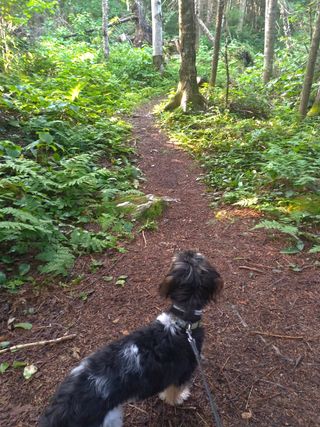
Choose the Right Trail
Thru-hiking with a dog is hard enough and you can make it easier by choosing the right trail. Dogs struggle over long distances, so a shorter trail is better. I found Chester was tired towards the end of the 275 mile Long Trail and I think he would have struggled on a trail that was much longer. Pick a trail that you know is within your dog’s ability, and be prepared to either take time off or send him home if he struggles.
Dogs also don’t do well in the heat, and need plenty of water. Choose a trail that doesn’t cross deserts to make it easier on your pup. Your dog also cannot carry as much weight as you (or in the case of small dogs like Chester, can’t carry anything at all), so unless you are ok with carrying large amounts of water for your dog, avoid trails with long stretches between water sources.
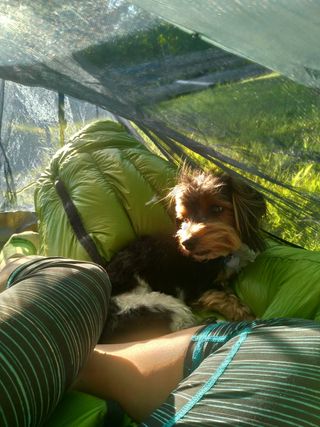
Hike Your Dog’s Hike
You’ve heard the saying “Hike Your Own Hike”. You cannot do this if you’re hiking with your pup. You have to hike your dog’s hike instead. Your pace is dictated by theirs. You have to stop when they’re tired. If they’re too hot, you better take a break in the shade. Your needs come second to your dog’s. If you can’t commit to this, you shouldn’t hike with your dog.

Take Care of Your Pup
Feet are important for people and dogs alike. Check your dog’s pads regularly. Some dogs wear booties, especially on rougher terrain, to protect their feet. Chester hates booties, so I carried him when we crossed rough slabs of rock, and on road walks. He was spoiled rotten, but that is part of what it took to hike with him.
Keep a close eye out for injuries. Your dog can’t tell you if they’re hurt. If they’re limping, lagging behind when previously they always lead the way, or otherwise change their behaviour, you should take some time off and visit a vet.
Depending on the trail you choose, you might also want to get your dog a tick collar and check them regularly for ticks. Chester is a tick magnet, and not only are they bad for him, I don’t want him transferring them to me when he gets in my sleeping bag.

Find a Vet
If the worst should happen and your pup becomes injured, you will have to take him to the vet. Vets aren’t common in the small towns along the trail. You also might not have service to google where the closest vet is. Vets are not listed on trail guides or maps. You can save yourself some panicked hitches to the wrong town by making a list of where the closest vets along the trail are before you leave.
Also, don’t forget to check in with your vet before you leave so they can give medical advice specific to your pup.
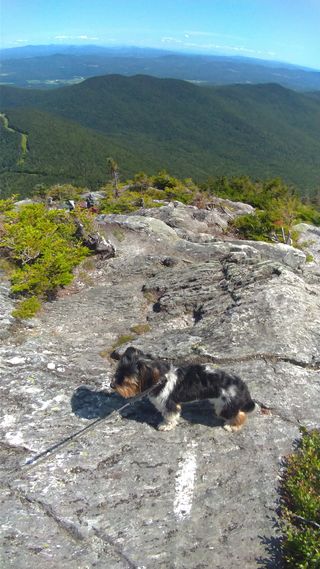
Hiker Hunger
People aren’t the only ones who get hiker hunger! Your dog is also likely to eat more than normal. Carry some extra food in case they eat more than expected. If your dog can tolerate small amounts of human food, they will appreciate the treat. One of my favourite Long Trail memories is Chester turning up the charm at a shelter close to the Massachusetts border so that a very hungry AT thru-hiker would give him his last piece of pepperoni. Dogs are definitely better at yogi-ing food than people.
If your dog has a specific diet, or gets sick if you change his food, you will have to mail resupply parcels with his food. Chester isn’t picky, so we were able to just buy the highest quality food in each pet store or grocery store along our route.
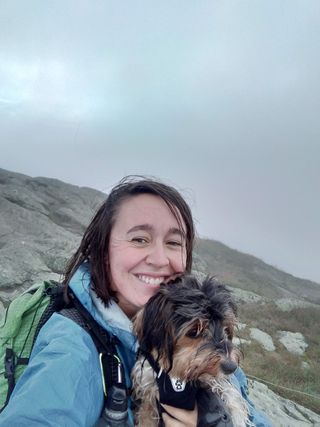
Leash Your Pup
Unless your dog has the best recall in the world, there’s too many distractions on the trail that could potentially injure your pup. Chester was interested in frogs, moose and porcupines on the Long Trail, and if he’d gotten too close, he would have lost the fight with all of them. Many people on the trail are also uncomfortable with dogs, and a leash helps to mitigate fears.
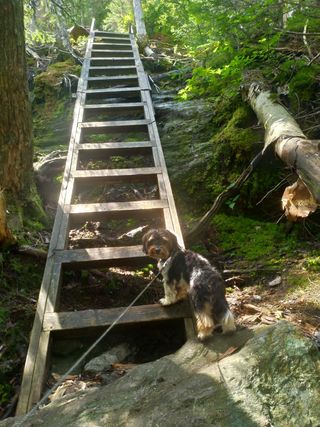
Leave No Trace
Leave no trace applies to doggo too. Either pack out their waste, or bury it in a cathole similar to how you would deal with your own poop. Keep them out of water sources, and don’t let them defecate within 200 ft of water. Be respectful of other hikers, farm animals, and wild animals.

Backpack
This tip only works if you have a small dog, but it is the single most useful tip for backpacking with dogs. Train your dog to ride on your shoulders, using your backpack to help them balance. We just tell Chester “backpack!” and he settles right down. This way you can carry your dog hands free (although I still keep a hand on Chester’s collar to catch him if he slips). If Chester is tired, hot, or we’re on a road walk, I can easily and safely carry him to our campsite.
If you’re hiking a scrambly trail, it’s a good idea to make sure your dog is comfortable being picked up, even if you don’t want to carry him. The Long Trail has multiple ladders that are too steep for a dog to scramble up without help. It was easy to tuck Chester under an arm, which made climbing ladders quick and easy.
Hiking with a dog is tough, but it can be incredibly rewarding too. Just make sure you always put the health and happiness of your dog first so they can enjoy the hike as much as you do.
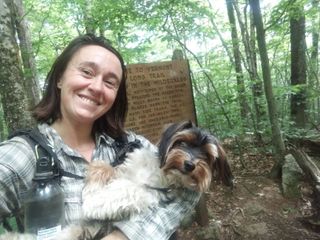
Blogs by Category
Thank you for your comment! It has been received and should show up here once it's approved.
Comments
None yet
